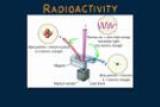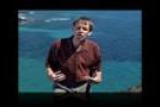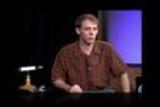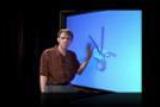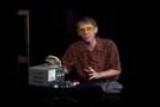Conceptual Integrated Science Explorations
Chapter 15: Nuclear Energy
Radioactivity
An overview of radioactivity, its history, its nature, and how it is detected. Duration: 6:53.
Chapter Introduction
John discusses the importance of learning about the atomic nucleus from the top of an extinct volcano rising some 20,000 feet above the ocean floor. Duration: 2:19.
The Discovery of Radioactivity
A talking head discussion of the discovery of radioactivity and the people who discovered. it. Duration: 4:30.
Three Different Types of Radiation
The properties of three different types of radiation are discussed. Duration: 4:18.
Penetrating Powers of Radiation
Radioactive samples are held up to a Geiger counter to demonstrate the differing penetrating powers of different types of radiation. Duration: 2:45.
Watch these additional videos to complete this tutorial.
Table of Videos
- Self Study Course Descriptions
-
Chapter 1: About Science
- 1.1 The Nature of Science
- 1.2 A Brief History of Advances In Science
- 1.3 Mathematics and Conceptual Science
- 1.4 The Scientific Method--A Classic Tool
- 1.5 The Scientific Hypothesis
- 1.6 The Value of Scientific Experiment
- 1.7 Facts, Theories, and Laws
- 1.8 Science Has Limitations
- 1.9 Science, Art, and Religion
- 1.10 Technology--The Practical Use of Science
- 1.11 What Is Integrated Science?
- 1.A An Investigation of Sea Butterflies
-
Chapter 2: Newton's First Law
- 2.1 Aristotle On Motion
- 2.2 Galileo's Concept of Inertia
- 2.3 Speed and Velocity
- 2.A Comparing Speeds
- 2.4 Motion Is Relative
- 2.5 Newton's First Law of Motion
- 2.6 Net Force--The Sum of All Forces On an Object
- 2.7 Equilibrium for Objects at Rest
- 2.8 The Support Force--Why We Don’t Fall Through the Floor
- 2.9 Equilibrium for Moving Objects
- 2.B Earth Moves Around the Sun
-
Chapter 3: Newton's Second Law
- 3.1 What Is Acceleration?
- 3.2 Force Causes Acceleration
- 3.3 Mass Is a Measure of Inertia
- 3.4 Mass and Acceleration Are Related
- 3.5 Newton’s Second Law
- 3.6 Friction
- 3.7 Objects In Free Fall Accelerate at the Same Rate
- 3.8 Why Objects in Free Fall Accelerate at the Same Rate
- 3.9 Air Drag
- 3.A Friction In Your Fingertips
- 3.B Gliding
-
Chapter 4: Newton's Third Law
- 4.1 A Force Is Part of an Interaction
- 4.2 Newton's Third Law--Action and Reaction
- 4.3 A Simple Rule Helps Identify Action and Reaction
- 4.4 Action and Reaction On Objects of Different Masses
- 4.5 Action and Reaction Forces Act On Different Objects
- 4.6 The Classic Horse-Cart Problem--A Mind Stumper
- 4.7 Action Equals Reaction
- 4.A Animal Locomotion
- 4.8 Summary of Newton's Three Laws
-
Chapter 5: Momentum
- 5.1 Momentum Is Inertia In Motion
- 5.2 Impulse Changes Momentum
- 5.3 Increasing Momentum—Increasing Force, Time, or Both
- 5.4 Practical Uses of the Impulse-Momentum Relationship
- 5.A The Impulse-Momentum Relationship In Sports
- 5.5 Momentum Is Conserved When No External Force Acts
- 5.6 Momentum Is Conserved In Collisions
-
Chapter 6: Energy
- 6.1 Work--Force x Distance
- 6.2 Power--How Quickly Work Gets Done
- 6.3 Mechanical Energy
- 6.4 Potential Energy Is Stored Energy
- 6.5 Kinetic Energy Is Energy of Motion
- 6.6 The Work-Energy Theorem
- 6.7 Conservation of Energy
- 6.8 Machines--Devices That Multiply Forces
- 6.9 Efficiency--A Measure of Work Done for Energy Spent
- 6.A Alternative Sources of Energy
- 6.B Energy for Life
-
Chapter 7: Gravity
- 7.1 The Falling Apple and the Falling Moon
- 7.2 Newton's Law of Universal Gravitation
- 7.3 Gravity, Distance, and the Inverse-Square Law
- 7.4 The Universal Constant of Gravitation, G
- 7.A Ocean Tides
- 7.5 Weight and Weightlessness
- 7.6 Projectile Motion
- 7.7 Fast-Moving Projectiles--Satellites
- 7.B Earth Satellites
-
Chapter 8: Heat
- 8.1 Thermal Energy
- 8.2 Temperature
- 8.3 Absolute Zero--Nature's Lowest Possible Temperature
- 8.4 What Is Heat?
- 8.5 Heat Units Are Energy Units
- 8.6 The Laws of Thermodynamics
- 8.7 Entropy
- 8.8 Specific Heat Capacity
- 8.A Specific Heat Capacity and Earth's Climate
- 8.9 Thermal Expansion
- 8.10 Heat Transfer: Conduction
- 8.11 Heat Transfer: Convection
- 8.12 Heat Transfer: Radiation
-
Chapter 9: Electricity
- 9.1 Electric Charge Is a Basic Characteristic of Matter
- 9.2 Coulomb's law--The Force Between Charged Particles
- 9.3 Charge Polarization
- 9.4 Electric Current--The Flow of Electric Charge
- 9.5 An Electric Current Is Produced By Electrical Pressure--Voltage
- 9.6 Direct Current and Alternating Current
- 9.7 Ohm's Law--The Relationship Between Current, Voltage, and Resistance
- 9.A Electric Shock
- 9.8 Direct Current and Alternating Current
- 9.9 Electric Power--The Rate of Doing Work
- 9.10 Electric Circuits--Series and Parallel
-
Chapter 10: Magnetism
- 10.1 Magnetic Poles--Attraction and Repulsion
- 10.2 Magnetic Fields
- 10.3 Magnetic Domains
- 10.4 Magnetic Fields Around Electric Currents
- 10.A Earth’s Magnetic Field
- 10.5 magnetic Forces on Moving, Charged Particles
- 10.6 Electromagnetic Induction--How Voltage Is Created
- 10.7 Generators and Alternating Current
- 10.8 The Induction of Fields--Both Electric and Magnetic
-
Chapter 11: Waves and Sound
- 11.1 Special Wiggles--Vibrations and Waves
- 11.2 Wave Motion--Transporting Energy
- 11.3 Two Types of Waves--Transverse and Longitudinal
- 11.4 Sound Travels In Waves
- 11.A Sensing Pitch
- 11.5 Speed of Sound
- 11.6 Sound Can Be Reflected
- 11.7 Sound Can Be Refracted
- 11.B Dolphins and Acoustical Imaging
- 11.8 Forced Vibrations and Natural Frequency
- 11.9 Resonance and Sympathetic Vibrations
- 11.10 Interference--The Addition and Subtraction of Waves
- 11.11 The Doppler Effect
-
Chapter 12: Light and Color
- 12.1 The Electromagnetic Spectrum
- 12.2 Why Materials Are Either Transparent or Opaque
- 12.3 Color Science
- 12.A Mixing Colored Lights
- 12.4 Mixing Colored Pigments
- 12.B Why the Sky Is Blue
- 12.C Why Sunsets Are Red
- 12.D Why Clouds Are White
-
Chapter 13: Properties of Light
- 13.1 Reflection of Light--Light Bouncing Off a Barrier
- 13.2 Refraction--The Bending of Light As Its Speed Changes
- 13.A Illusions and Mirages Are Caused by Atmospheric Refraction
- 13.B Light Dispersion and Rainbows
- 13.3 Diffraction--The Spreading of Light
- 13.4 Interference of Light Waves
- 13.5 Interference Colors by Reflection from Thin Films
- 13.6 Wave Particle Duality--Light Travels as a Wave and Strikes as a Particle
- 13.A Illusions and Mirages Are Caused by Atmospheric Refraction
- 13.B Light Dispersion and Rainbows
-
Chapter 14: The Atom
- 14.1 Discovering the Invisible Atom
- 14.A A Breath of Air
- 14.2 Evidence for Atoms
- 14.B A First Look at the Periodic Table
- 14.3 Protons and Neutrons
- 14.4 Isotopes and Atomic Mass
- 14.5 Electron Shells
-
Chapter 15: Nuclear Energy
- 15.1 Radioactivity
- 15.2 Alpha, Beta, and Gamma Rays
- 15.3 Environmental Radiation
- 15.A Radiation Damage to the Body
- 15.4 Transmutation of the Elements
- 15.5 Half-Life
- 15.B Isotopic Dating
- 15.6 Nuclear Fission
- 15.7 The Mass-Energy Relationship: E = mc(2)
- 15.8 Nuclear Fusion
-
Chapter 16: Elements of Chemistry
- 16.1 Chemistry: The Central Science
- 16.A Research
- 16.2 The Submicroscopic World
- 16.3 Change of Phase
- 16.4 Physical and Chemical Properties
- 16.5 Determining Physical and Chemical Changes
- 16.6 The Periodic Table
- 16.7 Elements and Compounds
- 16.8 Naming Compounds
-
Chapter 17: Bonds and Molecular Attractions
- 17.1 Electron-Dot Structures
- 17.2 The Formation of Ions
- 17.3 Ionic Bonds
- 17.A The Chemistry of Minerals
- 17.4 Metallic Bonds
- 17.5 Covalent Bonds
- 17.6 Polar Covalent Bonds
- 17.7 Molecular Polarity
- 17.8 Molecular Attractions
-
Chapter 18: How Chemical Mix
- 18.1 Most Materials Are Mixtures
- 18.2 The Chemist's Classification of Matter
- 18.3 Making Solutions
- 18.4 Concentration and the Mole
- 18.5 Solubility
- 18.6 Soaps and Detergents
- 18.A Purifying the Water We Drink
-
Chapter 19: How Chemicals React
- 19.1 Chemical Equations
- 19.2 Reaction Rates
- 19.A Catalysts and the Atmosphere
- 19.3 Energy and Chemical Reactions
- 19.4 Chemical Reactions Are Driven By Entropy
-
Chapter 20: Acids, Bases, and Redox
- 20.1 Acid and bases
- 20.2 Relative Strengths of Acids and Bases
- 20.3 Acidic, Basic, and Neutral Solutions
- 20.A Acid Rain and Basic Oceans
- 20.4 Losing and Gaining Electrons
- 20.5 Electrochemistry
- 20.6 Corrosion and Combustion
-
Chapter 21: Organic Compounds
- 21.1 Hydrocarbons
- 21.2 Unsaturated Hydrocarbons
- 21.3 Functional Groups
- 21.4 Alcohols and Ethers
- 21.5 Amine and Alkaloids
- 21.6 Carbonyl Compounds
- 21.7 Polymers
- 21.A The Molecules of Life
-
Chapter 22: The Basic Unit of Life: The Cell
- 22.1 What Is Life?
- 22.A The Big Molecules That Make Up Living Things
- 22.2 What Is a Cell?
- 22.3 The Two Types of Cells: Prokaryotic and Eukaryotic
- 22.B The Microscope
- 22.4 Tour of a Eukaryotic Cell
- 22.5 The Organelles of Eukaryotic Cells
- 22.6 The Cell Membrane
-
Chapter 23: How Cells Work
- 23.1 How Things Get In and Out of Cells
- 23.2 How Do Cells Reproduce?
- 23.3 Enzymes and the Chemical Reactions in Cells
- 23.A ATP Fuels Chemical Reactions in Cells
- 23.4 Photosynthesis
- 23.5 How Cells Get Energy
-
Chapter 24: DNA and Genes
- 24.1 What Is a Gene?
- 24.2 Chromosomes: Packages of Genetic Information
- 24.A The Structure of DNA
- 24.3 How DNA Is Copied
- 24.4 RNA
- 24.5 How Proteins Are Built
- 24.6 Meiosis and Genetic Diversity
-
Chapter 25: How Traits Are Inherited
- 25.1 Mendel's Peas
- 25.2 Mendel's First Law
- 25.3 Mendel's Second Law
- 25.4 More Wrinkles: Beyond Mendelian Genetics
- 25.5 The Human genome
- 25.6 Genetic Mutations
- 25.7 Cancer: A Genetic Disease
- 25.A Environmental Causes of Cancer
-
Chapter 26: The Evolution of Life
- 26.1 The Origin of Life
- 26.A Did Life On Earth Come From Mars?
- 26.2 How Living Things Change Over Time
- 26.3 The Key to Evolution: Natural Selection and How It Works
- 26.4 Adaptation
- 26.B Staying Warm and Keeping Cool: How Animals use Physics in Thermoregulation
- 26.5 Genetics and Evolution
- 26.6 How a New Species Forms
- 26.7 Evidence of Evolution
- 26.8 How Humans Evolved
-
Chapter 27: Diversity of Life
- 27.1 Classifying Living Things
- 27.2 Evolution and Classification
- 27.3 The Three Domains of Life
- 27.4 Bacteria
- 27.5 Archaea
- 27.6 Protists
- 27.7 Plants
- 27.8 Fungi
- 27.9 Animals
- 27.A Coral Bleaching
- 27.B How Birds Fly
- 27.10 Viruses and Prions
-
Chapter 28: Control and Development
- 28.1 How the Human Body Is Organized
- 28.2 The Brain
- 28.3 The Nervous System
- 28.4 How Neurons Work
- 28.A How Fast Can Action Potentials Travel?
- 28.B Endorphins
- 28.5 The Senses
- 28.6 Hormones
- 28.7 Reproduction and Development
- 28.8 The Skeleton and Muscles
-
Chapter 29: Care and Maintenance
- 29.1 Integration of Body Systems
- 29.2 The Circulatory System
- 29.A Hemoglobin
- 29.3 Respiration
- 29.4 Digestion
- 29.5 Nutrition, Exercise, and Health
- 29.B Low-Carb Versus Low-Calorie Diets
- 29.6 Excretion and Water Balance
- 29.7 Keeping the Body Safe: Defense Systems
-
Chapter 30: Ecosystems and Environment
- 30.1 Organisms and Their Environments
- 30.2 Species Interactions in Ecological Communities
- 30.3 Energy Flow in Ecosystems
- 30.A Energy Leaks When Organisms Eat
- 30.4 Kinds of Ecosystems
- 30.B Materials Cycling in Ecosystems
- 30.5 Change In an Ecosystem
- 30.6 Population Studies
- 30.7 Human Population Growth
-
Chapter 31: Plate Tectonics
- 31.1 Earth Science Is an Integrated Science
- 31.2 Earth's Composition
- 31.A Density and Earth's Layers
- 31.3 Earth's Structure
- 31.4 Continental Drift--An Idea Before Its Time
- 31.5 Seafloor Spreading
- 31.B Magnetic Stripes Are Evidence of Seafloor Spreading
- 31.6 The Theory of Plate Tectonics
- 31.C What Forces Drive the Plates?
- 31.7 Plate Boundaries
- 31.D Life In the Trenches
-
Chapter 32: Rocks and Minerals
- 32.1 What Is a Mineral?
- 32.2 Mineral Properties
- 32.3 Types of Minerals
- 32.A The Silicate Tetrahedron
- 32.4 How Do Minerals Form?
- 32.5 What Is Rock?
- 32.6 Igneous Rock
- 32.7 Sedimentary Rock
- 32.B Coal
- 32.8 Metamorphic Rock
- 32.9 The Rock Cycle
-
Chapter 33: Earth's Surface: Land and Water
- 33.1 Survey of the Earth
- 33.2 Folding and Faulting
- 33.3 Mountain Building
- 33.4 Plains and Plateaus
- 33.5 Earth's Waters
- 33.6 The Ocean
- 33.A The Composition of Ocean Water
- 33.7 Fresh Water
- 33.B Water Pollution
-
Chapter 34: Surface Processes
- 34.1 Weathering, Erosion, and Deposition--Agents of Change
- 34.A Weathering
- 34.2 Running Water
- 34.3 Glaciers
- 34.4 Mass Movement
- 34.5 Groundwater
- 34.6 Waves
- 34.7 Wind
-
Chapter 35: Weather
- 35.1 Atmosphere
- 35.A Atmospheric Pressure
- 35.2 The Structure of the Atmosphere
- 35.B Heating the Atmosphere
- 35.3 Temperature Depends of Latitude
- 35.4 Why Are There Seasons?
- 35.5 Flow of the Atmosphere--Wind
- 35.C Wind Chill
- 35.6 Some Winds Are Local--Others Are Global
- 35.D The Coriolis Effect
- 35.7 Ocean Currents Distribute Heat
- 35.8 Water In the Atmosphere
- 35.9 Changing Weather--Air Masses, Fronts, and Cyclones
-
Chapter 36: Earth's History
- 36.1 A Model of Earth's History
- 36.2 Telling Relative Time
- 36.A Dating a Rock--Telling AbsoluteTime
- 36.3 The Geologic Time Scale
- 36.B Precambrian Time
- 36.C The Paleozoic Era
- 36.D The Permian Extinction
- 36.E The Mesozoic Era
- 36.F The Cretaceous Extinction
- 36.G The Cenozoic Era
-
Chapter 37: Environmental Geology
- 37.1 Earthquakes
- 37.2 Tsunami
- 37.3 Volcanoes
- 37.4 Hurricanes
- 37.5 Earth's Past ad Present Climate
- 37.A Natural Causes of Climate Change
- 37.B Future Climate--A Warmer Earth?
-
Chapter 38: The Solar System
- 38.1 Earth's Moon
- 38.2 Eclipses—The Shadows of Earth and the Moon
- 38.3 Tour of the Solar System
- 38.A How Did the Solar System Form?
- 38.4 The Sun
- 38.5 The Inner Planets
- 38.6 The Outer Planets
- 38.B What Makes a Planet Suitable for Life?
- 38.7 Asteroids, Comets, and Meteoroids
-
Chapter 39: The Universe
- 39.1 Seeing Stars
- 39.2 The Light-year
- 39.3 The Birth of Stars
- 39.4 The Evolution and Death of Stars
- 39.5 The Bigger They Are, the Harder They Fall—Supernovae
- 39.6 Black Holes
- 39.7 Galaxies
- 39.A SETI
- 39.8 The Big Bang

